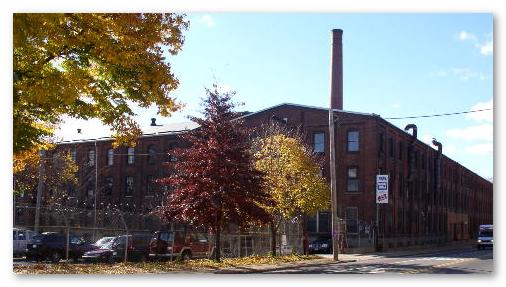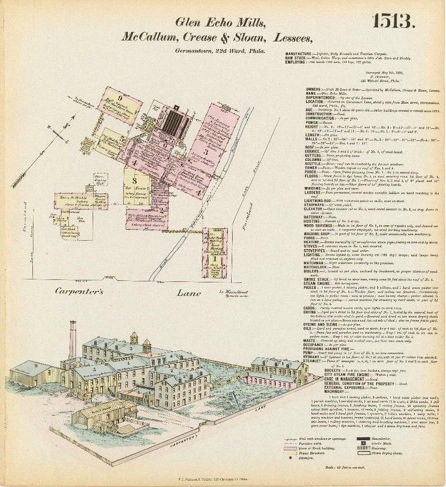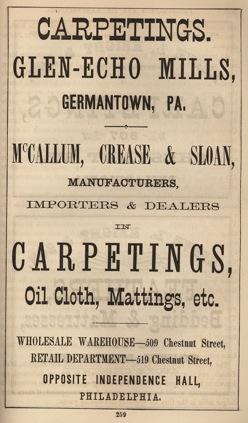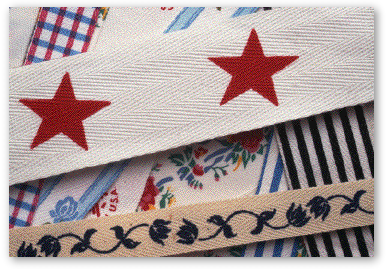
© Wayne Mills
New Glen Echo Mills, 1885
130 West Berkley Street, Philadelphia PA 19144
© Harold E. Spaulding,
Workshop of the
World (Oliver Evans Press, 1990).
The company that built the
New Glen Echo Mills on four and a half acres of land at
Wayne Junction Station in 1885 originated in 1830, when a
Scot named William McCallum began the manufacturing
ingrain carpets in a water-powered mill on Carpenter
Street in northern Germantown. The mill on Carpenter
Street had been built in 1812 to make cloth for soldiers'
uniforms. In it were constructed the first Jacquard
machines in this country, built by two Scots who were
McCallum's first employees.

Hexamer General Survey #1513 (1880), "Glen
Echo Mills, McCallum, Crease & Sloan,
Lessees."
Andrew McCallum was joined by his brother William in
1831, and together they bought from James Burk an
adjoining mill and 20 acres of land on Paper Mill Run,
where they proceeded to develop the first Glen Echo
Mills. In 1835, they added a steam engine and boiler; 10
years later, they built a 50-by-100-foot four story stone
mill for spinning. In 1846, six three-ply ingrain power
looms, built by Alfred Jenks of Bridesburg were
installed. They are said to be the first power looms in
Pennsylvania. By this time, the mills had become the
largest in the state; Andrew McCallum & Company now
employed 250 hands. 1

© Edwin T.
Freedley, Philadelphia
and its Manufactures (1867), p.
259.
Andrew McCallum died in 1859, and William became sole
proprietor. Four years later, when Hugh McCallum, Orlando
Crease, and A.J. Sloan joined the firm, it became known
as McCallum and Company. During the Civil War, the
company made army blankets; for a decade after the war,
ingrain carpets were its usual product. In 1875, the
company began making power-loomed Wilton and Brussels
carpets. By 1885, its growth and need for more space had
caused the company to relocate at Wayne Junction, where
it built the New Glen Echo Mills. 2
After Orlando Crease retired in 1887, the company became
McCallum and Sloan. Five years later, McCallum died,
Sloan retired, and Hugh McCallum's sons took over.
Shortly thereafter, the plant at Wayne Junction was sold
at sheriff's sale for $100,000 to a Mr. Price, said to
represent Orlando Crease. In 1908, the single story
weaving shed next to the railroad tracks was shared by H.
G. Fetteroff Wilton Carpet & Weaving and W. Scholes,
In-grain Carpets and Art Square Weaving. The Wayne
Junction Spinning Company and the Prudential Worsted
Company occupied the three story building. The one story
dye house next to the power plant was occupied by William
S. Lloyd.
Today, the plant is totally occupied by the Wayne Mills.

Printed Tapes, © Wayne
Mills
1 "Industries,
Graveyards, Firehouses," 1891, E.C. Jellett
Scrapbook, found at the Germantown Historical
Society Library, Call No. L-1/24, pg. 79
2 The original Glen Echo
Mills complex, located on Carpenter Street along Paper
Mill Run, was demolished in 1920, after being purchased
by a developer.
Update May
2007 (by
Linny Schenk & Michael Parrington):
Wayne Mills still occupies
the plant.
See
also:
Hexamer General Survey #294 (?), "Glen Echo
Mills, McCallum, Crease &
Sloan."
Hexamer General Survey #529 (?), "Glen Echo
Mills, McCallum, Crease &
Sloan."
Hexamer General Survey #1513 (1880), "Glen
Echo Mills, McCallum, Crease & Sloan,
Lessees."
Wayne Mills - corporate
website